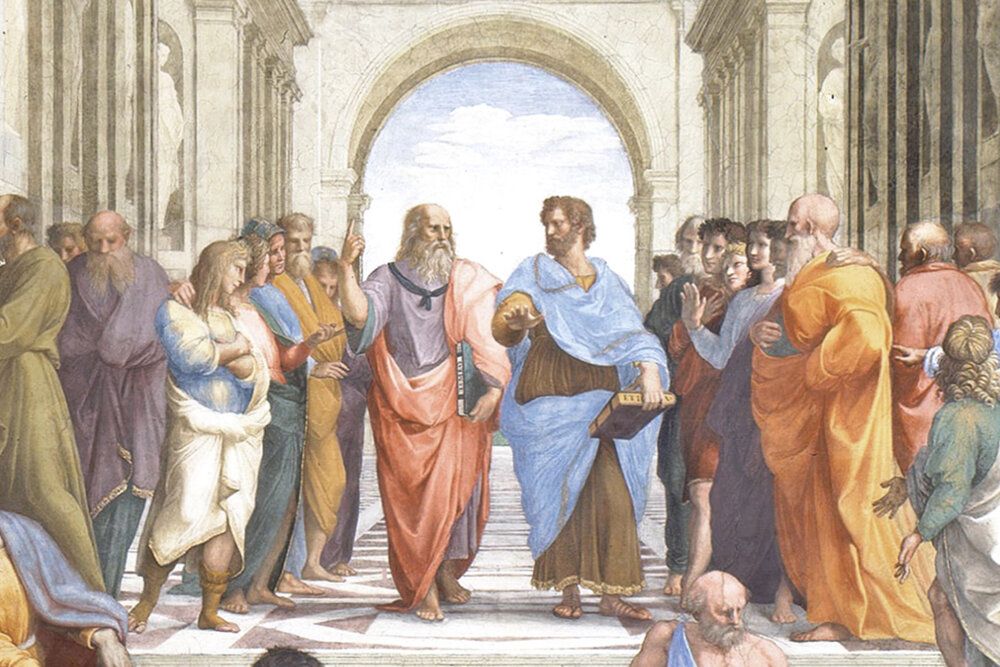The Aristocracy of Talent—A Review
Wooldridge argues that meritocracy can only survive if it is infused with an ethos that prioritizes virtue, applying talent to ends that ennoble rather than enrich.

A review of The Aristocracy of Talent: How Meritocracy Made the Modern World by Adrian Wooldridge. Allen Lane, 464 pages (June 2021)
Marcus Tullius Cicero was one of the most important literary figures of the ancient world, and today the study of Latin is divided between those who favor Cicero's crisp, elegant style and those who reject it as an artificiality. His extensive writings count for the majority of the Latin text we have preserved from his generation, so respected was his prose by his intellectual heirs in antiquity. An accomplished lawyer, philosopher of the skeptic school, and at times even a major political figure embroiled in the late Republican civil wars, Cicero achieved renown and stature in his own lifetime. His reputation and authority, however, were hard-won, taking a lifetime of hard work and accomplishment. Cicero was a novus homo, a “new man.” He had no illustrious forebears, so from obscure beginnings he had to earn a name for himself using his own wiles and wits. For modern Westerners, and especially Americans raised on the Horatio Alger mythology, the enormity of what it then meant to be a novus homo is befuddling. But for the ancients, those without connections and ancestors who dared to strive were seen as grasping, venal creatures, destabilizing the natural order of things.
In The Aristocracy of Talent: How Meritocracy Made the Modern World, Adrian Wooldridge unfurls a pacy narrative that recreates this lost world of inheritance and patrimony subsequently pushed aside by the merciless sorting procedures of modern meritocracy. In the process, he highlights the universal benefits of the new order, where in the natural course of things, the competent ascend the ladder of success. But he also documents the system’s recent corruption, and addresses how we can recapture its original progressive spirit in the future.
Wooldridge is now 62, so he has seen the post-World War II meritocracy at the peak of its powers, and bemoans its calcification and eventual capture by oligarchs. It is no coincidence that someone who values merit has spent most of his career as a columnist for the Economist—a publication that manages to distill and perpetuate the essence of 19th-century British classical liberalism for which a society open to the talents of all was the holy grail. However, The Aristocracy of Talent offers more than a standard recapitulation of history, as it eventually shifts to diagnosing the illness of modern meritocracy. It ends with a prognosis, and the steps needed to restore meritocratic health.
Though an Anglo-American perspective suffuses The Aristocracy of Talent, Wooldridge makes an effort to reach deep into history and broaden his lens so that the narrative covers cultures beyond the modern West. In the process, he brings the insights of domains as diverse as evolutionary psychology, political philosophy, and psychometrics to bear on Plato’s republic, the Chinese imperial system, and the British civil service. Meritocracy is not a historically contingent phenomenon, but a human universal which has been rationalized and placed at the center of our contemporary value system. In the distant past, no doubt, our ancestors would have preferred that the best hunters focus on obtaining game, while those with weaker skills engage in other activities. Today, the meritocratic impulse is not so prosaic, as talent and competency are also important to our values.
The indispensable meritocratic patina obtains even for oligarchic dynasties for whom higher education adds little direct value. Jared Kushner is heir to a multi-billion-dollar fortune, but his father nevertheless purchased a seat for him at Harvard University with a strategic donation. All the world’s wealth and breeding do not automatically confer the imprimatur of merit that matriculation at Harvard does. Though by all accounts, Kushner is an intellectual mediocrity, his Harvard degree gives him a glamor imparted from the institution, that in turn obtains its reputation from the ranks of bright young men and women of more modest means who aspire to be peers with the country’s best. In ancient Rome, a glorious lineage was sufficient to embark on a public career, but in the contemporary US, a degree from a prestigious university is arguably just as important.
In 2021, a book with the subtitle “How Meritocracy Made the Modern World” might be expected to peddle the idea that merit is a recent invention, but Wooldridge, who has a PhD in philosophy from Oxford, goes back to the source, fleshing out the political ideas espoused by Plato in The Republic. Plato’s vision for a republic ruled by merit has been alternatively labeled utopian and fascistic, but the depth and detail of that vision, in which a small competent elite chosen for their talent and virtue rule over the masses, has shaped Western civilization from its inception. Even though Athens was dominated by the will of the democratic citizenry, while Rome’s republic was guided by the interests of great patrician families, the seeds of technocratic meritocracy always existed as a counter-culture, beginning with Plato and continuing down through the ages. The vision in The Republic resurfaced in societies as varied as Elizabethan England, where Thomas More’s Utopia was a latter-day descendent of the original republic, and contemporary Iran, where Ayatollah Khomeini explicitly modeled the Guardian Council on Plato’s philosopher-kings.
And just as meritocracy’s origins were primal, so its appeal was also widespread. Between the Han Dynasty 2,000 years ago and the Song Dynasty 1,000 years ago, the Chinese perfected a meritocratic bureaucracy that obviated the need for a hereditary nobility. Consisting of original commentaries on the humanistic canon befitting a literary gentleman, the Chinese Imperial examinations continued until 1905, resurrected by every new ruling regime. So ubiquitous was the figure of the scholar-bureaucrat in Chinese culture that a whole genre of fiction emerged depicting the romance between a youthful examination candidate and a local beauty. And yet the flipside of the pressure-cooker of Chinese meritocracy was the opportunity cost of men devoting decades to passing exams that most would fail repeatedly. In the 19th century, the Taiping Rebellion, which killed millions, was triggered by a failed examination candidate’s nervous breakdown.
While the ancient Western vision of meritocracy was theoretical and philosophical, and the Chinese vision was functional and pragmatic, the third precedent, that of the Jews, was religious and theological. Though many religions fixate upon a core number of beliefs and major rituals, Judaism evolved into a legalistic faith that extended the 613 commandments handed down from God to the ancient Hebrews into all aspects of life. A tradition of Jewish religious commentary emerged 2,000 years ago whereby rabbis entered into competition with one another, to test their erudition and cleverness in interpreting the Bible. This dynamic process resulted in the Talmud, a set of commentaries that in bound form totals nearly 100 volumes. For much of the last 2,000 years, this intellectual subculture did not make waves outside the ghettos of Europe, but with the Jewish Enlightenment and emancipation in the 19th century, Jews broke into broader public life, and began to dominate numerous professions and fields. Wooldridge documents this impressive record of Jewish achievement, which includes over 20 percent of Nobel Prize winners, and the attempt by gentile elites to prevent Jewish advancement through quotas and explicit discrimination.
Meanwhile, Western societies finally embraced meritocracy whole-heartedly in the 19th century. Whereas earlier generations of university students at Oxford and Cambridge were exclusively the well-heeled sons of the landed nobility, in the 1800s, slots were opened for students with fewer connections and more talent. The Aristocracy of Talent tells of an older generation of Oxford dons who simply held sinecures, producing little in the way of scholarship or mentorship. This was the case throughout the British military and civil service as well, where expenditures were allotted to support the younger sons of privileged elites with connections, who had little to offer the Empire by way of talent, and who lived off the state as a parasitic class. The world before 1800 was defined by hereditary privilege, and the elites were shameless about the dynastic principle. To rule was their right, and the offices of state were their expectation. But war’s competitive pressures between European nation-states ensured that talented officers selected on merit would always beat gentry leaders who purchased their commissions through connections. The near-miss of the 1857 rebellion against the British in India brought home to the ruling caste of the Empire that employing layabouts and wastrels was a luxury they could no longer afford. Instead, the Empire quickly pivoted to deploying bright, classically educated men of the day who could competently and effectively rule a vast territory of hundreds of millions at minimum expense.

If Europeans—from the British civil service in India to the Napoleonic French officer corps—accepted meritocracy under cruel necessity, America’s aversion to heredity was part of its revolutionary inheritance. The US Constitution prohibits any person holding a government office from accepting title from any “King, Prince, or foreign State.” Though some early Founding Fathers, like Alexander Hamilton, were sympathetic to the aristocratic principle (of course, Hamilton himself was a novus homo), the election of Andrew Jackson in 1828 established democratic-populism as the dominant ethos of the American republic. Despite the Jackson administration’s reputation for corruption and graft, Wooldridge notes that its openness to outsiders meant that it expanded the pool of the ruling class far beyond the small number of elite north-eastern families preferred by the Federalist party. Though a fully professionalized civil service would only come to full fruition with the progressive era in the early 20th century, Jackson’s rejection of the hereditary principle and known connections opened the door through which pure meritocracy would eventually step.
The 20th century is rightfully called the American century, as the powers of Europe tore themselves apart in two World Wars and the Soviet Union’s vision of worldwide Communism lost the clash of ideologies. But it was arguably also the century of meritocracy, as America’s emphasis on ingenuity, hard work, and individual initiative propelled it to become the technological and economic vanguard by the mid-20th century. Whereas the ancient Romans viewed a novus homo with suspicion, and Napoleon rightly understood that his parvenu status meant he would always be excluded from the club of European monarchs, in America self-made men were seen to be superior specimens to the scions of dynastic power. The existence of Gilded-Age dynasties like the Astors and Vanderbilts flew in the face of the ideal, which valorized individual new men like Andrew Carnegie, the self-made mogul, born the son of a modest weaver.
Wooldridge outlines how, in the decades after World War II, America’s institutions of excellence threw open their doors to any and all with talent, from Jews to women, and so transformed themselves into supercharged engines of upward mobility. George W. Bush matriculated at Yale in 1964, while his younger brother, Jeb, attended the University of Texas starting in 1971. The difference between the two young men did not reflect their native talent, but the shift to a stricter academic criteria at Yale in the late 1960s. While universities rolled out the red carpet for bright students of all kinds, the Immigration and Nationality Act of 1965 allowed the promise of America to be realized for people from all over the world who had previously been shut out. Whereas the 1924 Immigration Act attempted to maintain the ethnic balance of the US at the time, biased as it was towards north-west Europeans, the 1965 legislation encouraged the migration of vast numbers of individuals from Asia and Africa. It included clauses that prioritized those with critical skills, so that 52 percent of start-ups in Silicon Valley are now co-founded by an immigrant.
But Wooldridge warns that in the last few decades, orthodoxy of merit has been assailed from multiple directions even in the US. The 1965 wave of immigration resulted in a massive increase in the US’s Asian population, and the flooding of its elite institutions with their children. Fear of demographic imbalance has led institutions to impose disparate standards to reduce the number of ethnic Asian admittees, policies that are strikingly reminiscent of the Jewish quotas of the 1920s. The rationales in 21st-century America for these Asian quotas are often left-wing. Administrators steeped in Critical Race Theory take a dim view of the possibilities of meritocracy, and through some contorted logic view Asian success as a symptom of white supremacy, to be stamped out. From the standpoint of admissions officers, the systems and institutions of 20th-century America were not open and fair, but systematically biased to reinforce status hierarchies. Over-representation of particular groups reveals the effects of that bias, not hard work. Meanwhile, the Varsity Blues admissions scandal exposed wealthy families trying to purchase slots for their children at elite institutions, attempting to scoop up some of the glamor that super-wealthy students, like Jared Kushner, take for granted. Sub-elite lineages operating on dynastic logic attempt to co-opt and parasitize the meritocracy rather than nakedly undermine its legitimacy.
Meanwhile, Wooldridge observes that much of the American public has become detached from and hostile to elite meritocratic institutions, particularly academia. Working-class Americans who have never been near the meritocratic ladder feel oppressed by the cultural changes wrought by the intelligentsia, and targeted for ridicule by those with credentials they lack. In the United Kingdom, to the shock of the media and political elite, citizens voted to leave the European Union beloved by the professional-managerial class. But the Brexit vote was just the denouement of the British working class’s long alienation from the urbane cosmopolitans of London. Far from a means of upward mobility and competence, they see meritocratic institutions as elitist vehicles intent on imposing their solutions from on high. While the American system balanced meritocratic technocracy and popular democracy in the past, today its populist democratic energies have been unleashed against the attempts by the technocracy to impose its will by fiat. The rise to power of Donald Trump and Boris Johnson reflects populist anger in the Anglo-American world. Though both Trump and Johnson are sons of privilege, with the former inheriting great wealth and the latter attaining stupendous academic success, they affect an air of buffoonery often necessary for aspirant populists from the upper classes.
Is meritocracy, then, a legacy of the 20th century, set to slowly wither in the 21st? The Aristocracy of Talent is rich with the evidence of incredible yields from the meritocratic project. The modern world’s professional class is an outcome of the meritocracy, as are the rule of law and the global order. Gains from free trade and free movement of capital have enriched all. But the turn against meritocracy has as much to do with the transformation of meritocrats into rational agents lacking virtue and moral balance. The Left’s critique of elite universities has bite when you consider that Harvard and other prestigious institutions have become hedge funds attached to nonprofits, investing as much time and energy in their endowments as they do in educating their undergraduate student bodies. The fact that a Harvard degree confers status, rather than a badge of virtue, means it is less ridiculous when someone like Jared Kushner waltzes onto campus. One can debate whether an oligarch’s son has the academic chops, but rarely would anyone argue that their presence graces the campus with more virtue. As it is, Kushner has the wealth that many Harvard students routinely aspire to obtain when they leave campus to become McKinsey management consultants and investment bankers.
Wooldridge argues that meritocracy can only survive if it is infused with an ethos that prioritizes virtue, applying talent to ends that ennoble rather than enrich. This insight is not original to The Aristocracy of Talent; to wit, Adam Smith penned The Theory of Moral Sentiments 15 years before An Inquiry into the Nature and Causes of the Wealth of Nations. Smith’s view of rational capitalism, maximizing the wealth of all, was always understood in the context of ethics and morality, something moderns too often forget. The same reality applied to the Chinese meritocratic system, where success occurred through study and commentary on treatises, the focus of which was virtue and propriety. Like the British civil servants of the 19th century, Chinese bureaucrats were educated in the humanities, and well understood that their power was but a means to an end, enabling the “good life” for the greatest number.
Nineteenth-century meritocracy succeeded because the competition between nation states tested various forms of governance, and the utility of having competent soldiers and bureaucrats was argument enough for Europe’s rulers. But after a century of rule by technocrats, the novelty of argument from efficiency has faded. Too often meritocrats are seen as ruthlessly selfish, focusing on their own interests rather than putting their skills at the service of the body politic. The 21st century requires a rediscovery of meritocracy as an ethos, rather than a prosaic career ladder and a set of checkboxes. Wooldridge reminds us that life is not just hoops through which we must jump to win accolades. Talents are gifts that must serve society, and with the privilege to rule comes responsibility.











